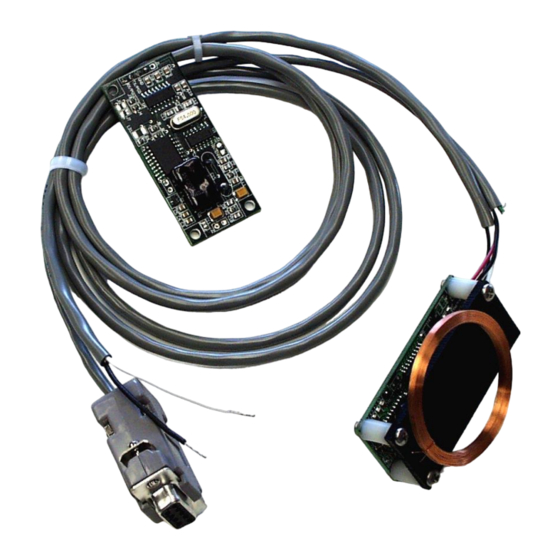
Summary of Contents for RFID 3020 Series
- Page 1 MODEL 3020 SERIES READ ONLY and READ WRITE 125 KHz MicroReader OPERATING MANUAL Version 08.19 (represents month/year)
-
Page 2: Table Of Contents
The conversion to Acrobat has a tendency to move sections, as the fonts do not translate perfectly. Contact us: RFID, Inc. 14190 E. Jewell Avenue Suite 4 Aurora, CO 80012 303-366-1234 phone 303-366-1222 fax info@rfidinc.com... -
Page 3: Quick Start Guide
1) Install the Windows based Demo Software from the CD-ROM provided in this kit (open the CD, open the RFID Terminal Program and Evaluation KHz Program folders, run Setup and follow the prompts), execute that Windows based program. Plug the Reader’s serial cable into your PC’s serial port and power the Reader. - Page 4 00, 08, 10, or 18. You must place the Reader into the correct Tag type mode in order for programming to occur. At the bottom of the screen in RFID, Inc.’s Terminal Program, select the “V” button and the Reader responds displaying which mode it is in. Select the “M8” button to cycle to the next mode as ordered above.
-
Page 5: Section 1 General Information
5 volt AC Power Supply with Power jack con 1.2 DESCRIPTION The Model 3020 series of MicroReaders read and/or reprogram electronic Tags (transponders), interfacing to a PC or logic device through a serial port. The Reader provides a half-duplex asynchronous bit serial data stream, interfacing to various equipments compatible with RS-232-C specifications and offers TTL output. -
Page 6: Specifications
1.3 SPECIFICATIONS Frequency: 125 KHz (passive Tags) Read Write: 8, 16, or 32 ASCII characters Protocol: Half-duplex, RS-232, TTL, (Wiegand to be released) Baud Rate: 9600 default (19200 optional from factory) Bits Per Character: Parity: None Stop Bits: Error Rate: Less than 1 in 10 to the 14 readings Serial Connector:... -
Page 7: Section 2 Preparing To Operate The Reader
SECTION 2 PREPARING TO OPERATE THE READER 2.1 POWER CONNECTION The Model 3020 MicroReader offers a low power consumption of just 5vdc and a typical current draw of 125 mA, maximum 200 mA. The Model 3020 MicroReader is deliverable in two connection types. The Reader can be ordered with its standard bare pins for ready attachment of power and communication wiring, or with an AMP connector pre-wired with 9 PIN D Sub serial connector and/or a single male pole connector for power. -
Page 8: Dip Switch Block
Terminal Equipment (DTE) device receives data on Pin 2 and transmits data on Pin 3. Your PC’s COM port is most likely configured as Data Terminal Equipment (DTE). Most terminals and IBM-PC compatible interfaces have 9 pin COM ports configured as DTE, but if your control device’s 9 pin COM port does not receive on pin 2, there exist simple converters called modem eliminators, which accomplish the crossing of pins 2 and 3 for you. -
Page 9: Tag Versions
2.4 TAG VERSIONS It is important to understand the Tag versions RFID, Inc. offers on our 125 KHz product line, if you intend to write to more than one type of Tag. RFID, Inc. uses 4 different EEPROM ASIC chips for its RW Tags and 1 ROM chip for its RO Tags. -
Page 10: Antenna Cable
2.5 ANTENNA CABLE (if an externally cabled Antenna is employed) The Antenna lengths, 12’, 19’ or 30’, are custom and part of the Antenna’s attenuated circuit, therefore altering the length of the Antenna cable will affect read and write range between the Antenna and a Tag. Custom cables can be accommodated without losing read range by altering capacitance at the PCB. -
Page 11: Section 3 Operating The Microreader
The MicroReader recognizes both a closed square bracket and a carriage return as the same keystroke. All programming must be done in capital letters. If you are using the RFID, Inc. terminal program you may notice the program automatically converts any data input to be written, into capitals. - Page 12 There are basically only 5 commands available with the Model 3020-RW, the Mode and Tag Version command, the Write command, and the Single or Duplicate Tag Report Mode command. Mode Command Enter: [Mxx] where xx equals the mode desired Response: OK If mode 18 is desired, enter [M18] Version Command This command allows the user to ascertain which Tag Mode the Reader is in for writing purposes.
-
Page 13: Advanced Tag Memory Options
Many different options are available to you. RFID, Inc. does offer Reader versions utilizing lock bits, that once executed will lock all or part of the Tag’s data, irreversibly. Differing Tag memory management can also be made available using 8, 16, or 32 ASCII characters. -
Page 14: Relay Driver
RFID, Inc. products are warranted against defects in materials and workmanship for one (1) year from date of shipment. RFID, Inc. shall, at its option, either repair or replace products that prove to be defective and are returned with freight prepaid to RFID, Inc.’s plant within the warranty period. The foregoing warranty shall not apply to defects resulting from abuse, misuse, accident, alteration, neglect or unauthorized repair or installation.


Need help?
Do you have a question about the 3020 Series and is the answer not in the manual?
Questions and answers